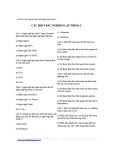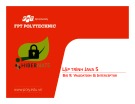
Table of Contents
Sample Configuration for Authentication in RIPv2........................................................................................1
Document ID: 13719................................................................................................................................1
Introduction..........................................................................................................................................................1
Prerequisites.........................................................................................................................................................1
Requirements..........................................................................................................................................1
Components Used...................................................................................................................................1
Conventions............................................................................................................................................2
Background Information......................................................................................................................................2
Configure.............................................................................................................................................................2
Network Diagram....................................................................................................................................2
Configurations........................................................................................................................................3
Configuring Plain Text Authentication...................................................................................................3
Configuring MD5 Authentication...........................................................................................................5
Verify...................................................................................................................................................................6
Verifying Plain Text Authentication.......................................................................................................6
Verifying MD5 Authentication...............................................................................................................7
Troubleshoot........................................................................................................................................................8
Troubleshooting Commands...................................................................................................................8
Related Information.............................................................................................................................................9
Cisco − Sample Configuration for Authentication in RIPv2
i

Sample Configuration for Authentication in RIPv2
Document ID: 13719
Introduction
Prerequisites
Requirements
Components Used
Conventions
Background Information
Configure
Network Diagram
Configurations
Configuring Plain Text Authentication
Configuring MD5 Authentication
Verify
Verifying Plain Text Authentication
Verifying MD5 Authentication
Troubleshoot
Troubleshooting Commands
Related Information
Introduction
This document shows sample configurations for authenticating the routing information exchange process for
Routing Information Protocol version 2 (RIPv2).
Cisco implementation of RIPv2 supports two modes of authentication: plain text authentication and Message
Digest 5 (MD5) authentication. Plain text authentication mode is the default setting in every RIPv2 packet,
when authentication is enabled. Plain text authentication should not be used when security is an issue, because
the unencrypted authentication password is sent in every RIPv2 packet.
Note: RIP version 1 (RIPv1) does not support authentication. If you are sending and receiving RIPv2 packets,
you can enable RIP authentication on an interface.
Prerequisites
Requirements
Readers of this document should have the basic understanding of the following:
RIPv1 and RIPv2•
Components Used
This document is not restricted to specific software and hardware versions. Starting from Cisco IOS®
Software Version 11.1, RIPv2 is supported and therefore all the commands given in the configuration are
supported on Cisco IOS® Software Version 11.1 and later.
Cisco − Sample Configuration for Authentication in RIPv2

The configuration in the document is tested and updated using these software and hardware versions:
Cisco 2500 Series Router•
Cisco IOS Software Version 12.3(3)•
The information in this document was created from the devices in a specific lab environment. All of the
devices used in this document started with a cleared (default) configuration. If your network is live, make sure
that you understand the potential impact of any command.
Conventions
For more information on document conventions, see the Cisco Technical Tips Conventions.
Background Information
Security is one of the primary concerns of network designers today. Securing a network includes securing the
exchange of routing information between routers, such as ensuring that the information entered into the
routing table is valid and not originated or tampered by someone trying to disrupt the network. An attacker
might try to introduce invalid updates to trick the router into sending data to the wrong destination, or to
seriously degrade network performance. In addition, invalid route updates might end up in the routing table
due to poor configuration (such as not using the passive interface command on the network boundary), or due
to a malfunctioning router. Because of this it is prudent to authenticate the routing update process running on
a router.
Configure
In this section, you are presented with the information to configure the features described in this document.
Note: To find additional information on the commands used in this document, use the Command Lookup
Tool ( registered customers only) .
Network Diagram
This document uses the network setup shown in the diagram below.
The network above, which is used for the following configuration examples, consists of two routers; router
RA and router RB, both of which are running RIP and periodically exchanging routing updates. It is required
that this exchange of routing information over the serial link be authenticated.
Cisco − Sample Configuration for Authentication in RIPv2

Configurations
Carry out these steps to configure authentication in RIPv2:
Define a key chain with a name.
Note: The key chain determines the set of keys that can be used on the interface. If a key chain is not
configured, no authentication is performed on that interface.
1.
Define the key or keys on the key chain.2.
Specify the password or key−string to be used in the key.
This is the authentication string that must be sent and received in the packets using the routing
protocol being authenticated. (In the example given below, the value of the string is 234.)
3.
Enable authentication on an interface and specify the key chain to be used.
Since authentication is enabled on a per interface basis, a router running RIPv2 can be configured for
authentication on certain interfaces and can operate without any authentication on other interfaces.
4.
Specify whether the interface will use plain text or MD5 authentication.
The default authentication used in RIPv2 is plain text authentication, when authentication is enabled
in the previous step. So, if using plain text authentication, this step is not required.
5.
Configure key management (This step is optional).
Key management is a method of controlling authentication keys. This is used to migrate form one
authentication key to another. For more information, refer to the "Manage Authentication Keys"
section of Configuring IP Routing Protocol−Independent Features.
6.
Configuring Plain Text Authentication
One of the two ways in which RIP updates can be authenticated is using plain text authentication. This can be
configured as shown in the tables below.
RA
key chain kal
!−−− Name a key chain. A key chain may contain more than one key for added security.
!−−− It need not be identical on the remote router.
key 1
!−−− This is the Identification number of an authentication key on a key chain.
!−−− It need not be identical on the remote router.
key−string 234
!−−− The actual password or key−string.
!−−− It needs to be identical to the key−string on the remote router.
!
interface Loopback0
Cisco − Sample Configuration for Authentication in RIPv2

ip address 70.70.70.70 255.255.255.255
!
interface Serial0
ip address 141.108.0.10 255.255.255.252
ip rip authentication key−chain kal
!−−− Enables authentication on the interface and configures
!−−− the key chain that will be used.
!
router rip
version 2
network 141.108.0.0
network 70.0.0.0
RB
key chain kal
key 1
key−string 234
!
interface Loopback0
ip address 80.80.80.1 255.255.255.0
!
interface Serial0
ip address 141.108.0.9 255.255.255.252
ip rip authentication key−chain kal
clockrate 64000
!
router rip
version 2
network 141.108.0.0
network 80.0.0.0
For detailed information on the commands, refer to the Cisco IOS IP command reference.
Cisco − Sample Configuration for Authentication in RIPv2




















![Đề thi cuối kì Nhập môn Mạng máy tính: Tổng hợp [Năm]](https://cdn.tailieu.vn/images/document/thumbnail/2025/20251110/nminhthoi53@gmail.com/135x160/38281762757217.jpg)



![Đề thi học kì 2 môn Nhập môn Mạng máy tính [kèm đáp án]](https://cdn.tailieu.vn/images/document/thumbnail/2025/20251014/lakim0906/135x160/23811760416180.jpg)

